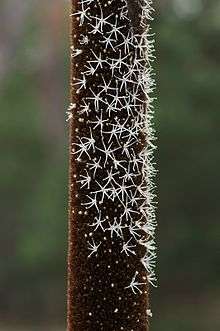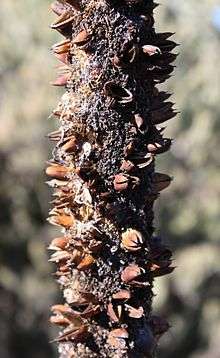Xanthorrhoea
| Xanthorrhoea | |
|---|---|
| | |
| X. semiplana | |
| Scientific classification | |
| Kingdom: | Plantae |
| Clade: | Angiosperms |
| Clade: | Monocots |
| Order: | Asparagales |
| Family: | Asphodelaceae |
| Subfamily: | Xanthorrhoeoideae |
| Genus: | Xanthorrhoea Sol. ex Sm. |
| Species | |
| | |
| Distribution of Xanthorrhoea | |
| Synonyms[1] | |
|
Acoroides Sol. ex Kite, not validly published | |
Xanthorrhoea (/zænθoʊˈriːə/[2]) is a genus of about 30 species of flowering plants endemic to Australia and a member of family Asphodelaceae, being the only member of subfamily Xanthorrhoeoideae.[1] The Xanthorrhoeoideae are monocots, part of order Asparagales.[3]
Names
A reference to its yellow resin,[2] Xanthorrhoea literally means "yellow flow" in Ancient Greek. Smith named it in 1798,[4] from xanthos (‘yellow, golden’) and rhœa (‘flowing, flow’).[2] The invalid Acoroides (‘Acorus-like’[5]) was a temporary designation in Solander's manuscript from his voyage with Cook, originally not meant for publication.[4]
Common names for Xanthorrhoea include grasstree, grass gum-tree (for its resin-yielding species),[2] and blackboy, based on the purported similarity in appearance of the trunked species to an Aboriginal man holding an upright spear. The last name is now considered offensive to Aborigines, or at least belonging to the past.
In the South West, the Noongar name balga is used for X. preissii. In South Australia, Xanthorrhoea is commonly known as yakka, also spelled yacca and yacka, a name probably from a South Australian Aboriginal language,[6] mostly likely Kaurna.
Description

All are perennials and have a secondary thickening meristem in the stem. Many, but not all, species develop an above ground stem. This is rough-surfaced, built from accumulated leaf-bases around the secondarily thickened trunk. The trunk is sometimes unbranched, some species will branch if the growing point is damaged, and others naturally grow numerous branches.
Flowers are borne on a long spike above a bare section called a scape; the total length can be up to four metres long in some species. Flowering occurs in a distinct flowering period, which varies for each species. Flowering can be stimulated by bushfire, in which case it occurs in the next flowering period after the fire.
Growth rates
The rate of growth of Xanthorrhoea is very slow. However, this is often generalized to mean they all grow at the rate of about an inch (2½ cm) per year. Actually, after the initial establishment phase, the rate of growth varies widely from species to species. Thus, while a five-metre-tall member of the fastest-growing Xanthorrhoea may be 200 years old, a member of a more slowly growing species of equal height may have aged to 600 years.
Cultivation
Xanthorrhoea may be cultivated, as seed is easily collected and germinated. While they do grow slowly, quite attractive plants with short trunks (10 cm) and leaf crowns up to 1.5 m (to the top of the leaves) can be achieved in 10 years. The slow growth rate means that it can take 30 years to achieve a specimen with a significant trunk. Most Xanthorrhoea sold in nurseries are established plants taken from bushland. Nurseries charge high prices for the plants. However, there is a very low survival rate for nursery-purchased plants, which may take 3–4 years to die. The most successful examples of transplanting have been where a substantial amount of soil (> 1 cubic metre) has been taken with the plants.
Traditional Aboriginal uses
Xanthorrhoea is important to the Aboriginal people who live where it grows. The flowering spike may be utilized as the back half of a composite spear shaft. [7] It is also soaked in water and the nectar from the flowers gives a sweet-tasting drink. In the bush the flowers could reveal directions, since flowers on the warmer, sunnier side – usually north – of the spike often open before the flowers on the cooler side facing away from the sun.[8]
The resin from Xanthorrhoea plants is used in spear-making[9] and is an invaluable adhesive for Aboriginal people, often used to patch up leaky coolamons (water containers) and even yidaki (didgeridoos). The dried flower stalk scape was also used to generate fire by the hand drill friction method.
European use
Resin collected from the plant was used in Australia until the mid-twentieth century for the following purposes:[10]
- Burnt as an incense in churches.
- A base component for a varnish used on furniture and in dwellings.
- A polish and a coating used on metal surfaces including stoves, tin cans used for storing meat and “brass instruments.”
- A component used in industrial process associated with “sizing paper, in soap making, perfumery and in manufacturing early gramophone records.”
Similar plants
Kingia and Dasypogon are unrelated Australian plants with a similar growth habit to Xanthorrhoea. Both genera have at times been confused with xanthorrhoeas and misnamed as "grasstrees". Some plant classification systems such as Cronquist[11] have included a wide range of other genera in the same family as Xanthorrhoea. However, later anatomical and phylogenetic research has supported the view of Dahlgren[12] who regarded Xanthorrhoea as the sole member of his family Xanthorrhoeaceae sensu stricto, which is now treated as the subfamily Xanthorrhoeoideae.[13]
Species

According to the World Checklist of Selected Plant Families, as of September 2014 the following species are accepted[1]
- Xanthorrhoea acanthostachya D.J.Bedford - WA (Western Australia)
- Xanthorrhoea acaulis (A.T.Lee) D.J.Bedford - NSW
- Xanthorrhoea arborea R.Br. - NSW
- Xanthorrhoea arenaria D.J.Bedford - Tas
- Xanthorrhoea australis R.Br. - NSW SA Tas Vic
- Xanthorrhoea bracteata R.Br. - Tas
- Xanthorrhoea brevistyla D.A.Herb. - WA
- Xanthorrhoea brunonis Endl. in J.G.C.Lehmann - WA
- Xanthorrhoea caespitosa D.J.Bedford - SA
- Xanthorrhoea concava (A.T.Lee) D.J.Bedford - NSW
- Xanthorrhoea drummondii Harv. - WA
- Xanthorrhoea fulva (A.T.Lee) D.J.Bedford - NSW, Qld
- Xanthorrhoea glauca D.J.Bedford - NSW, Qld, Vic
- Xanthorrhoea gracilis Endl. in J.G.C.Lehmann - WA
- Xanthorrhoea johnsonii A.T.Lee - NSW, Qld
- Xanthorrhoea latifolia (A.T.Lee) D.J.Bedford - NSW, Qld
- Xanthorrhoea macronema F.Muell. ex Benth. - NSW, Fraser Island in Qld
- Xanthorrhoea malacophylla D.J.Bedford - NSW
- Xanthorrhoea media R.Br. - NSW
- Xanthorrhoea minor R.Br. - NSW, Vic, SA
- Xanthorrhoea nana D.A.Herb. - WA
- Xanthorrhoea platyphylla D.J.Bedford - WA
- Xanthorrhoea preissii Endl. in J.G.C.Lehmann (syn. Xanthorrhoea pecoris F.Muell.) - WA
- Xanthorrhoea pumilio R.Br. - Qld
- Xanthorrhoea quadrangulata F.Muell. - SA
- Xanthorrhoea resinosa Pers. (syn. Xanthorrhoea hastilis Pers. - NSW, Vic
- Xanthorrhoea semiplana F.Muell. - SA, Vic
- Xanthorrhoea thorntonii Tate - WA, NT, SA
 X. australis flower spike, flowering
X. australis flower spike, flowering X. preissii flower spike, after fruiting
X. preissii flower spike, after fruiting
See also
- Kingia – an unrelated genus, but of similar appearance
References
- 1 2 3 Kew World Checklist of Selected Plant Families
- 1 2 3 4 "xanthorrhoea". Oxford English Dictionary (3rd ed.). Oxford University Press. September 2005. (Subscription or UK public library membership required.) "Bot. (With capital initial.)"
- ↑ Bedford, D. J. (1986). "Xanthorrhoea", in: A. S. George, (Ed) Flora of Australia 46:148–169. ISBN 0-644-04356-3.
- 1 2 Nelson, E. Charles (June 1993). "The names of the Australian grass-tree: Xanthorrhoea Sin. and Acoroides C. Kite (Xanthorrhoeaceae)". Botanical Journal of the Linnean Society. 112 (2): 95–105. doi:10.1006/bojl.1993.1044.
- ↑ Gledhill, D. (2008). The Names of Plants. Cambridge U. Press. p. 35. ISBN 978-0-521-86645-3.
- ↑ Peters, Pam, The Cambridge Australian English Style Guide, Cambridge University Press, 1996, p823. ISBN 978-0-521-57634-5
- ↑ http://koorihistory.com/grass-tree-resin/ Hard Yakka! Grass Tree Resin (Xanthorrhoea)
- ↑ Gardening Australia - Fact Sheet: Xanthorrea
- ↑ Quantum - Ancient Resin
- ↑ Watson, Phil (2004), The Grass Tree: Its Uses and Abuses, Association of Societies for Growing Australian Plants, retrieved 20 April 2016
- ↑ Cronquist, A.J. An Integrated System of Classification of Flowering Plants, Columbia University Press, New York 1981. ISBN 0231038801
- ↑ Dahlgren, R. M. T. (1980). "A revised system of classification of the angiosperms". Botanical Journal of the Linnean Society. 80 (2): 91–124. doi:10.1111/j.1095-8339.1980.tb01661.x.
- ↑ Chase, Mark W.; Reveal, James L.; Fay, Michael F. (2009). "A subfamilial classification for the expanded asparagalean families Amaryllidaceae, Asparagaceae and Xanthorrhoeaceae". Botanical Journal of the Linnean Society. 161 (2): 132–6. doi:10.1111/j.1095-8339.2009.00999.x.
External links
| Wikimedia Commons has media related to Xanthorrhoea. |
- Xanthorrhoea australis - R.Br. Plants For A Future
- XANTHORRHOEA INFORMATION PAGE Monica Pawlan
- "Xanthorrhoea". FloraBase. Western Australian Government Department of Parks and Wildlife.

- Xanthorrhoea, Australian Plant Name Index (APNI)
- "The grass tree: its uses and abuses". ASGAP Wildlife and Native Plants Study Group newsletter. ASGAP. Summer 2001–2002. Retrieved 2010-05-16.